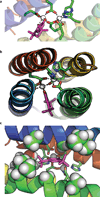Designed metalloprotein stabilizes a semiquinone radical
- PMID: 27001731
- PMCID: PMC4857601
- DOI: 10.1038/nchem.2453
Designed metalloprotein stabilizes a semiquinone radical
Abstract
Enzymes use binding energy to stabilize their substrates in high-energy states that are otherwise inaccessible at ambient temperature. Here we show that a de novo designed Zn(II) metalloprotein stabilizes a chemically reactive organic radical that is otherwise unstable in aqueous media. The protein binds tightly to and stabilizes the radical semiquinone form of 3,5-di-tert-butylcatechol. Solution NMR spectroscopy in conjunction with molecular dynamics simulations show that the substrate binds in the active site pocket where it is stabilized by metal-ligand interactions as well as by burial of its hydrophobic groups. Spectrochemical redox titrations show that the protein stabilized the semiquinone by reducing the electrochemical midpoint potential for its formation via the one-electron oxidation of the catechol by approximately 400 mV (9 kcal mol(-1)). Therefore, the inherent chemical properties of the radical were changed drastically by harnessing its binding energy to the metalloprotein. This model sets the basis for designed enzymes with radical cofactors to tackle challenging chemistry.
Figures




References
-
- DeGrado WF, Summa CM, Pavone V, Nastri F, Lombardi A. De novo design and structural characterization of proteins and metalloproteins. Annu. Rev. Biochem. 1999;68:779–819. - PubMed
-
- Dürrenberger M, Ward TR. Recent achievements in the design and engineering of artificial metalloenzymes. Curr. Opin. Chem. Biol. 2014;19:99–106. - PubMed
-
- Faiella M, Roy A, Sommer D, Ghirlanda G. De novo design of functional proteins: toward artificial hydrogenases. Biopolymers. 2013;100:558–571. - PubMed
Publication types
MeSH terms
Substances
Grants and funding
LinkOut - more resources
Full Text Sources
Other Literature Sources

